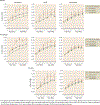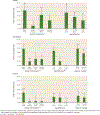A Contagion Model for Within-Family Transmission of Drug Abuse
- PMID: 30818984
- PMCID: PMC6487075
- DOI: 10.1176/appi.ajp.2018.18060637
A Contagion Model for Within-Family Transmission of Drug Abuse
Abstract
Objective: The purpose of this study was to determine whether, controlling for genetic effects, drug abuse was transmitted within families as predicted by a contagion model.
Methods: The authors examined 65,006 parent-offspring, sibling, and cousin pairs ascertained from Swedish population registries in which the primary case subject had a drug abuse registration. The rate of drug abuse registration among at-risk secondary case subjects ages 19-23 was studied. Utilizing matched control pairs, a difference-in-difference approach was used to infer causal effects.
Results: In offspring, risk for drug abuse registration in the 3 years after an index registration of a parent residing in the same household, neighborhood, or municipality increased 5.9%, 3.4%, and 1.8%, respectively. For siblings of sibling index case subjects, parallel results were 5.9%, 3.9%, and 1.2%. For cousins of cousin index case subjects, excess risk for those in the same neighborhood or municipality was 2.9% and 0.9%, respectively. In all sets of relatives, drug abuse transmission was strongest in male-male pairs and in pairs closest in age. In sibling pairs, stronger transmission was observed in older to younger siblings compared with younger to older siblings. Transmission was stronger within than across the two drug classes with sufficient data (opiates and cannabis).
Conclusions: These results suggest that drug abuse can be transmitted within families by an environmentally mediated temporally defined model of contagion. The most important methodological limitation is that drug abuse registration is an inaccurate measure of the onset of drug abuse. Indeed, as predicted, drug abuse risk increased among potential secondary case subjects in the year before drug abuse registration of the index case subject.
Keywords: Families; Psychoactive Substance Use Disorder.
Conflict of interest statement
The authors report no financial relationships with commercial interests.
Figures




Similar articles
-
Within-Family Transmission of Alcohol Use Disorder in Parent-Offspring, Sibling, and Cousin Pairs: A Contagion Model.J Nerv Ment Dis. 2020 Sep;208(9):637-645. doi: 10.1097/NMD.0000000000001190. J Nerv Ment Dis. 2020. PMID: 32502073 Free PMC article.
-
Within-family environmental transmission of drug abuse: a Swedish national study.JAMA Psychiatry. 2013 Feb;70(2):235-42. doi: 10.1001/jamapsychiatry.2013.276. JAMA Psychiatry. 2013. PMID: 23229904 Free PMC article.
-
Genetic and family and community environmental effects on drug abuse in adolescence: a Swedish national twin and sibling study.Am J Psychiatry. 2014 Feb;171(2):209-17. doi: 10.1176/appi.ajp.2013.12101300. Am J Psychiatry. 2014. PMID: 24077613 Free PMC article.
-
Psychoactive drug abuse in older adults.Am J Geriatr Pharmacother. 2006 Dec;4(4):380-94. doi: 10.1016/j.amjopharm.2006.10.002. Am J Geriatr Pharmacother. 2006. PMID: 17296542 Review.
-
Illnesses in siblings of US patients with bipolar disorder relate to multigenerational family history and patients severity of illness.J Affect Disord. 2017 Jan 1;207:313-319. doi: 10.1016/j.jad.2016.09.042. Epub 2016 Oct 6. J Affect Disord. 2017. PMID: 27741468 Review.
Cited by
-
Geographic proximity is associated with transmission of suicidal behaviour among siblings.Acta Psychiatr Scand. 2019 Jul;140(1):30-38. doi: 10.1111/acps.13040. Epub 2019 Jun 10. Acta Psychiatr Scand. 2019. PMID: 31102549 Free PMC article.
-
Contagion models for the transmission of drug abuse among propinquity-of-rearing defined acquaintances: A Swedish national study.Drug Alcohol Depend. 2019 Aug 1;201:94-100. doi: 10.1016/j.drugalcdep.2019.03.027. Epub 2019 Jun 4. Drug Alcohol Depend. 2019. PMID: 31203149 Free PMC article.
-
Immigrant enclaves and risk of drug involvement among asylum-seeking immigrants in Sweden: A quasi-experimental study.Drug Alcohol Depend. 2019 Dec 1;205:107666. doi: 10.1016/j.drugalcdep.2019.107666. Epub 2019 Oct 25. Drug Alcohol Depend. 2019. PMID: 31710993 Free PMC article.
-
Contagious Transmission in a Swedish National Sample of Alcohol Use Disorders as a Function of Geographical Proximity Among Siblings and Propinquity-of-Rearing Defined Acquaintances.J Stud Alcohol Drugs. 2023 Sep;84(5):670-679. doi: 10.15288/jsad.23-00003. Epub 2023 May 18. J Stud Alcohol Drugs. 2023. PMID: 37219029 Free PMC article.
-
Whole Genome Sequencing of Pedigrees With High Density of Substance Use and Psychiatric Disorders: A Meeting Report.Genes Brain Behav. 2025 Feb;24(1):e70017. doi: 10.1111/gbb.70017. Genes Brain Behav. 2025. PMID: 39935334 Free PMC article.
References
-
- Merikangas KR, Stolar M, Stevens DE, et al.: Familial transmission of substance use disorders. Arch Gen Psychiatry 1998; 55:973–979 - PubMed
-
- Tsuang MT, Bar JL, Harley RM, et al.: The Harvard Twin Study of Substance Abuse: what we have learned. Harv Rev Psychiatry 2001; 9:267–279 - PubMed
-
- Kendler KS, Prescott CA: Cannabis use, abuse, and dependence in a population-based sample of female twins. Am J Psychiatry 1998; 155:1016–1022 - PubMed
-
- Lynskey MT, Heath AC, Nelson EC, et al.: Genetic and environmental contributions to cannabis dependence in a national young adult twin sample. Psychol Med 2002; 32:195–207 - PubMed
Publication types
MeSH terms
Grants and funding
LinkOut - more resources
Full Text Sources
Medical

